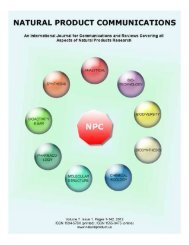This Issue is Dedicated to the Memory of Professor Ivano Morelli
This Issue is Dedicated to the Memory of Professor Ivano Morelli
This Issue is Dedicated to the Memory of Professor Ivano Morelli
Create successful ePaper yourself
Turn your PDF publications into a flip-book with our unique Google optimized e-Paper software.
NPC<br />
Natural Product Communications<br />
Triterpenes from Maytenus macrocarpa and Evaluation <strong>of</strong><br />
Their Anti-HIV Activity<br />
2006<br />
Vol. 1<br />
No. 12<br />
1073 - 1078<br />
Sonia Piacente a , Lourdes Campaner Dos San<strong>to</strong>s b , Naheed Mahmood c and Cosimo Pizza a,*<br />
a Dipartimen<strong>to</strong> di Scienze Farmaceutiche, University <strong>of</strong> Salerno, via Ponte Don Melillo, 84084<br />
F<strong>is</strong>ciano, Salerno, Italy<br />
b Institu<strong>to</strong> de Quimica, UNESP, CP335, CEP 14801-970 Araraquara, SP, Brazil<br />
c Retroscreen Ltd, Academic Virology, London Hospital, Whitechapel, 64 Turner Street, London<br />
E1 2AD, U.K.<br />
pizza@un<strong>is</strong>a.it<br />
Received: September 8 th , 2006; Accepted: November 2 nd , 2006<br />
<strong>Dedicated</strong> <strong>to</strong> <strong>the</strong> memory <strong>of</strong> Pr<strong>of</strong>essor <strong>Ivano</strong> <strong>Morelli</strong>.<br />
A set <strong>of</strong> pentacyclic triterpenes has been <strong>is</strong>olated from <strong>the</strong> bark <strong>of</strong> Maytenus macrocarpa (Celastraceae). It includes two new<br />
olean-12-ene derivatives, namely 3β, 22α-dihydroxy-olean-12-en-30-oic acid (1) and 22α-hydroxy-olean-12-en-3-oxo-30-oic<br />
acid (2), and <strong>the</strong> new urs-12-ene derivative 3-(E)-coumaroyluvaol (7), along with 10 known compounds possessing olean-12-<br />
ene, urs-12-ene, lupane and friedelane skele<strong>to</strong>ns. The structures have been elucidated by extensive spectroscopic methods<br />
including 1D- and 2D-NMR experiments, as well as ESI-MS analys<strong>is</strong>. All <strong>is</strong>olated compounds were tested for anti-HIV<br />
activity in C8166 cells infected with HIV-1 MN . The most active compound was 22α-hydroxy-12-en-3-oxo-29-oic acid<br />
(triterpenonic acid A, 4), with an EC 50 value <strong>of</strong> 1 μg/mL and a selectivity index <strong>of</strong> 35.<br />
Keywords: Maytenus macrocarpa, Celastraceae, pentacyclic triterpenes, anti-HIV activity.<br />
Species belonging <strong>to</strong> <strong>the</strong> genus Maytenus<br />
(Celastraceae) have been used as a traditional<br />
medicine in <strong>the</strong> Amazonian region against cancer,<br />
rheumat<strong>is</strong>m, and inflammation [1-2]. M. macrocarpa<br />
(R & P) Briquet <strong>is</strong> endemic <strong>to</strong> <strong>the</strong> Amazonian region<br />
<strong>of</strong> Peru and an alcoholic infusion <strong>of</strong> its bark <strong>is</strong> used,<br />
generally in “aguardiente”, for <strong>the</strong> treatment <strong>of</strong><br />
rheumat<strong>is</strong>m, influenza, gastrointestinal d<strong>is</strong>eases, and<br />
as an antitumor agent for skin cancer [3]. In previous<br />
papers, dammarane [3] and friedelane triterpenes [4]<br />
from <strong>the</strong> stem bark exudates, sesquiterpene polyol<br />
esters from <strong>the</strong> leaves [5], and <strong>the</strong> nortriterpenes<br />
macrocarpins A-D from <strong>the</strong> roots [6] <strong>of</strong><br />
M. macrocarpa have been reported. Fur<strong>the</strong>rmore a<br />
dihydro-β-agar<strong>of</strong>uran sesquiterpene <strong>is</strong>olated from <strong>the</strong><br />
roots <strong>of</strong> M. macrocarpa has been reported <strong>to</strong> act as a<br />
modula<strong>to</strong>r <strong>of</strong> daunomycin res<strong>is</strong>tance in a multidrugres<strong>is</strong>tant<br />
Le<strong>is</strong>hmania tropica line. [7].<br />
Here we report <strong>the</strong> <strong>is</strong>olation and characterization<br />
<strong>of</strong> three new triterpenes from <strong>the</strong> bark <strong>of</strong><br />
M. macrocarpa, namely 3β, 22α-dihydroxy-12-en-<br />
30-oic acid (1), 22α-hydroxy-12-en-3-oxo-30-oic<br />
acid (2) and 3-(E)-p-coumaroyluvaol (7), along with<br />
<strong>the</strong> known olean-12-ene derivatives maytenfolic acid<br />
(3), trip<strong>to</strong>triterpenonic acid A (4), 22-epi-maytenfolic<br />
acid (5), 22-epi-trip<strong>to</strong>triterpenonic acid A (6), <strong>the</strong><br />
urs-12-ene derivative 3-(E)-caffeoyluvaol (8), <strong>the</strong><br />
lupane-type triterpenes 3-(E)-p-coumaroylbetulin (9),<br />
3-(Z)-p-coumaroylbetulin (10), 3-(E)-caffeoylbetulin<br />
(11), nepeticin (12), and friedelane orthosphenic acid<br />
(13). On <strong>the</strong> bas<strong>is</strong> <strong>of</strong> <strong>the</strong> anti-HIV activity reported<br />
for triterpenes closely related <strong>to</strong> compounds 1-13<br />
<strong>is</strong>olated from M. macrocarpa [8-10], <strong>the</strong> inhibi<strong>to</strong>ry<br />
activity <strong>of</strong> <strong>the</strong>se compounds against HIV-1<br />
replication in acutely infected C8166 cells has been<br />
evaluated.







